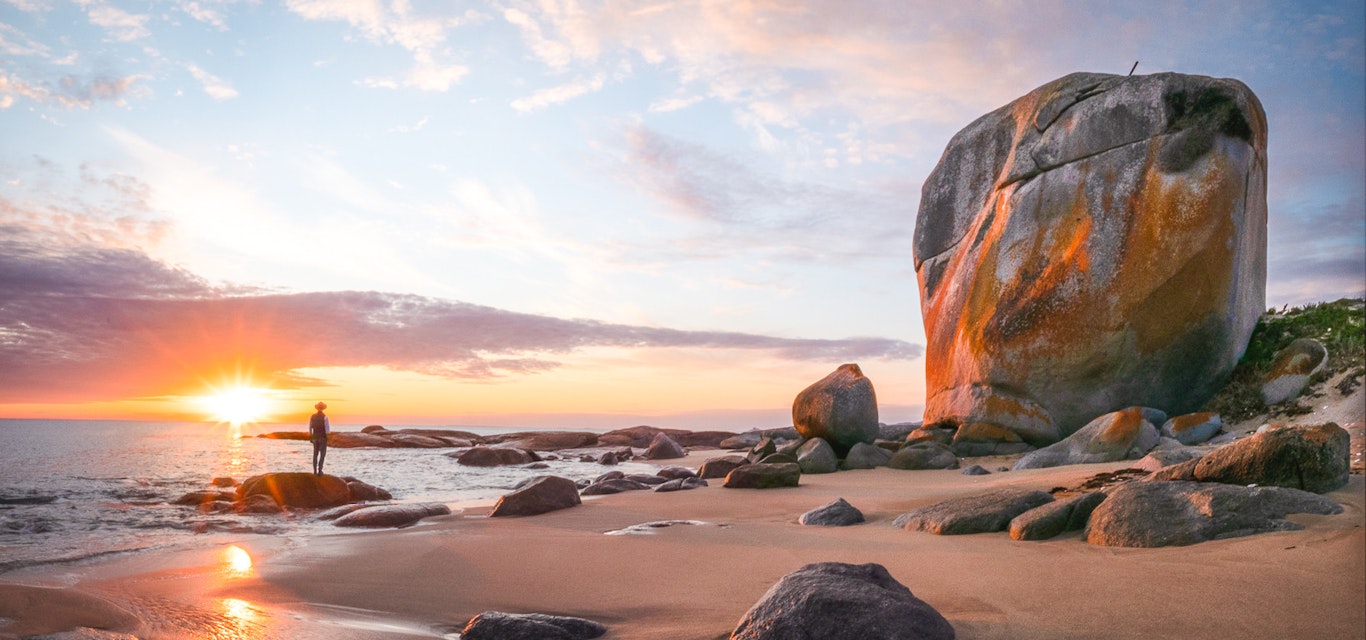Is this Tasmania's best walking destination?
Andrew Bain takes on Flinders Island by foot to answer this question.
At the eastern edge of Bass Strait, an island rises dramatically from the sea. Granite peaks bubble up from whitesand beaches. Wildlife blithely ambles about, and boulders blazed in orange lichen are strewn along the coast like art installations.
The largest of the 52 islands in the Furneaux Group, Flinders Island is like the best bits of natural Tasmania – Freycinet’s peaks, the Bay of Fires’ beaches and colours – distilled into an even smaller island. It’s little wonder that it harbours some of Tasmania’s finest walks, with three of the state’s 60 Great Short Walks on the island. Every beach and mountain on this wondrous island is an invitation to step out and explore.
Taking on the mountain
Dominating Flinders Island’s south are the Strzelecki Peaks, which rise directly and dramatically out of Bass Strait. Armoured in bare granite cliffs and underlined by beaches and farmland, the 756-metre-high mountains are the island’s ultimate day out in boots.
The climb to the range’s summit is steep, transitioning from tea-tree thickets into fern-lined gullies, damp mossy glades and wind-pruned scrub around the exposed summit.
On a fine day, over the top of neighbouring Cape Barren Island, the Tasmanian mainland is visible 60 kilometres away.
The rewards for effort on the four- to five-hour Strzelecki Peaks Great Short Walk are ample, with the wind-whipped summit – and various points along the climb – unveiling some of Tasmania’s best coastal views. Trousers Point is splayed out below, bookended by two of the island’s most beautiful beaches, and Bass Strait is dotted with a constellation of islands. On a fine day, over the top of neighbouring Cape Barren Island, the Tasmanian mainland is visible 60 kilometres away.
Credit: Andrew Bain
Credit: Andrew Bain
Credit: Dietmar Kahles
Credit: Stu Gibson
Credit: Stu Gibson
Taking up the trousers
If you’ve only seen one photo of Flinders Island, it’s likely to have been of Trousers Point, the southern headland that presents a classic scene of white sand, blue seas and lichen-covered granite, set to a backdrop of the Strzelecki Peaks.
Trousers Point Great Short Walk – the second of the island’s Great Short Walks – loops around the hook-shaped point, beginning at Trousers Point Beach, where granite boulders bulge like knuckles along the water’s edge. As the 90-minute walk threads north along the rocky coast, Mt Chappell Island – home to the world’s largest tiger snakes – hovers offshore, looking like a sombrero atop the sea, before the trail turns into Fotheringate Bay. Less celebrated than Trousers Point Beach, this long beach is no less fascinating or beautiful, with shallow limestone caves lining its southern end, granite boulders littering its sands and the Strzelecki Peaks towering above.
The loop walk swings back to Trousers Point Beach along a quiet dirt road, but the more interesting return is to retrace your steps along the ragged and rugged coast.
Credit: Andrew Bain
Credit: Andrew Bain
King of the castle
Cast your eye along Flinders Island’s west coast and one enormous rock dominates. Ballooning out of the sand on Marshall Bay, Castle Rock is the star feature of the third of the island’s Great Short Walks.
Castle Rock Great Short Walk sets out from beside Allports Beach. The 90-minute walk hops between beaches, rounding tussock-covered headlands, and finally striding out on long Marshall Beach to the base of the granite boulder, which towers over everything but the dunes behind it. The rockpools around the base of the rock are like mini marine worlds, and the granite slabs invite lounging, so plan to stick around a while before wandering back to Allports Beach.
Rock at the Dock
In the island’s north, the coastal traverse from Killiecrankie to The Dock (or vice versa) isn’t a Great Short Walk, and yet it might well be the island’s best walk. From Killiecrankie, the five- to six-hour return walk rounds the long beach on Killiecrankie Bay. Just before leaving the bay, the track drops onto the sands of Stackys Bight, where a limestone arch curls off the tiny beach into the sea, looking like something transplanted from the tropics.
At the tip of the bay, the walk rounds Old Man’s Head, a massive, sentinel-like boulder, before skirting coastal rock slabs, with the imposing cliffs of Mt Killiecrankie – favourites with rock climbers – towering overhead.
Past a rustic climbers’ camp, the walk drops into The Dock, where Flinders Island turns natural design into artistry. Granite islets dot the bay, boulders sit piled in mounds, and the cliffs of Mt Killiecrankie and Split Rock form a fortress-like surround. There’s nothing to regret about walking here, except the need to eventually leave.
